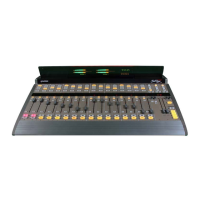Revision A • 6/06
HARRIS CORPORATION
4-12
4 Linking the NetWave
When this macro is taken, the signal from
the Telco device (input 71 on a card frame) is
routed to channel 5 (this channel 5 source was
defined as Telco 1 during console setup). The
Telco 1 mix-minus signal is then routed to the
Telco device connected to output 93 on the card
frame.
Each route in a Router Command section is
taken, in order, when the macro file is loaded or
taken. Macros can be loaded by using a com-
mand line interface on the setup computer or
by taking the macro, just as if it were a source,
on a Dual Router or a Source Selector panel.
Routes taken by a macro file are continuously
maintained until another macro file is loaded
that changes the source-to-destination routing
or when a new source is selected on a Dual
Router or a Source Selector panel for the desti-
nation. Routes are held, even if the console or
its parent device loses power, by a “persistence
file” that is constantly being updated as routes
are taken.
Multiple Routes
The macro examples shown so far route one
source to one destination, but any one source
can be routed to multiple destinations by sim-
ply adding additional Take command lines.
However, the converse does not apply: only
one signal can be routed to a destination. Rout-
ing a second signal to a destination removes
the first route’s signal, replacing it with the sig-
nal defined in the second route.
NetWave Logic Routing
When the channel’s signal source is set as
Net Audio with Logic, the routed audio signal
from the VistaMax system has logic commands
embedded in the audio signal header to control
the channel. The commands available to con-
trol a NetWave channel are: channel on/off, cue
on, cough, ready, talk to CR and talk to Studio.
Any other logic commands assigned in VMCC
are ignored by NetWave channels.
Conversely, each NetWave channel sends logic
commands to the VistaMax system using the
header of that channel’s VistaMax source sig-
nal—even when that signal is not the active
source for the channel. Typically, the only com-
mands used are the channel on and channel off
commands. They can be used to trigger VistaMax
logic I/O card outputs to send out either Tally
or pulse commands.
To do this, the logic signals are routed from
the channel to a Logic I/O card using route
commands. Here is an example:
[RouterCommand_1]
take_1=D40.257,D40.130
take_2=D40.259,D40.131
This shows the first two channels of a Net-
Wave (connected to device 40, Hub 0, Facet 4)
being routed to the first two timeslots of a logic
card in slot 4 of an Envoy card frame (set as
device 40). Here the NetWave channel audio is
only used as a carrier, since it is the logic com-
mands in the header that trigger the logic card
outputs. What commands are output were set in
the Logic Outputs pane of VMCC.
The VistaMax or Envoy manuals have addi-
tional information on VistaMax logic usage.
VMCC, Showing Studio Mic Input Logic Assignments

